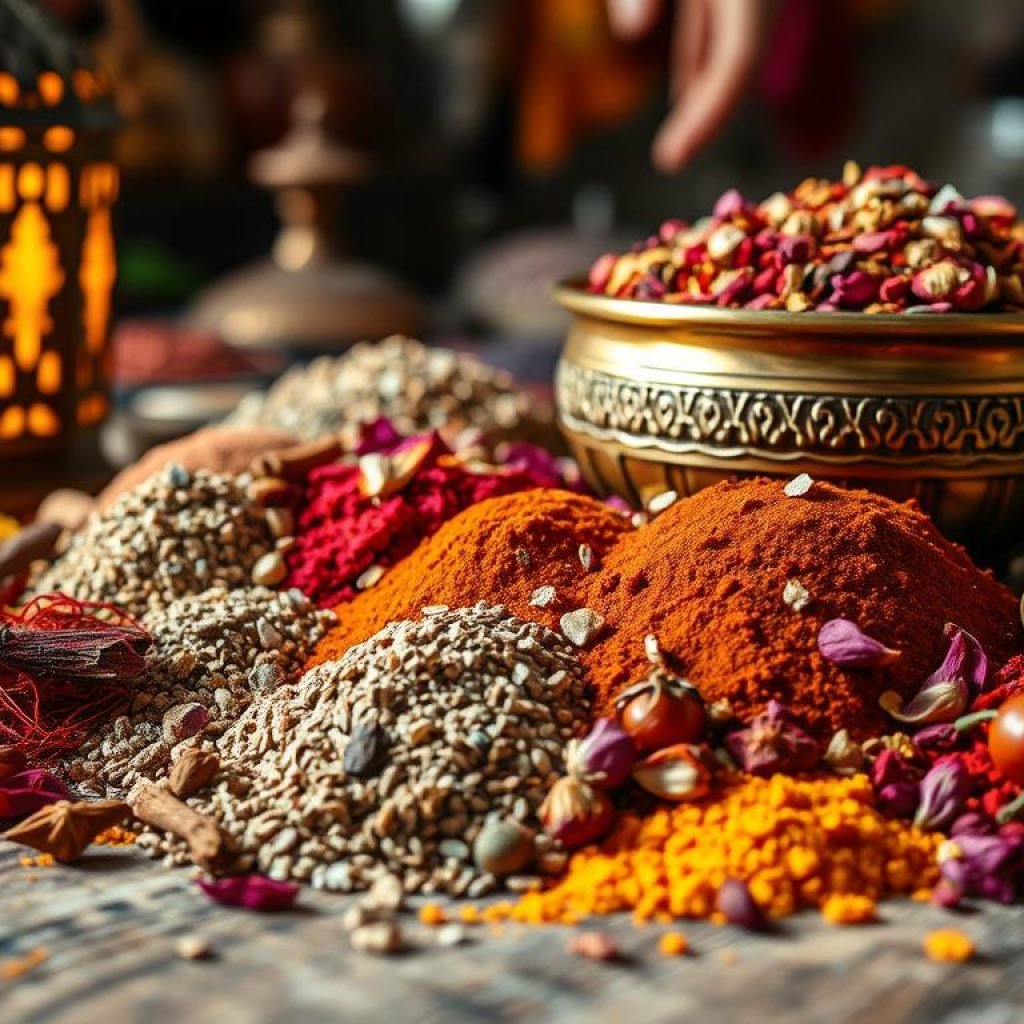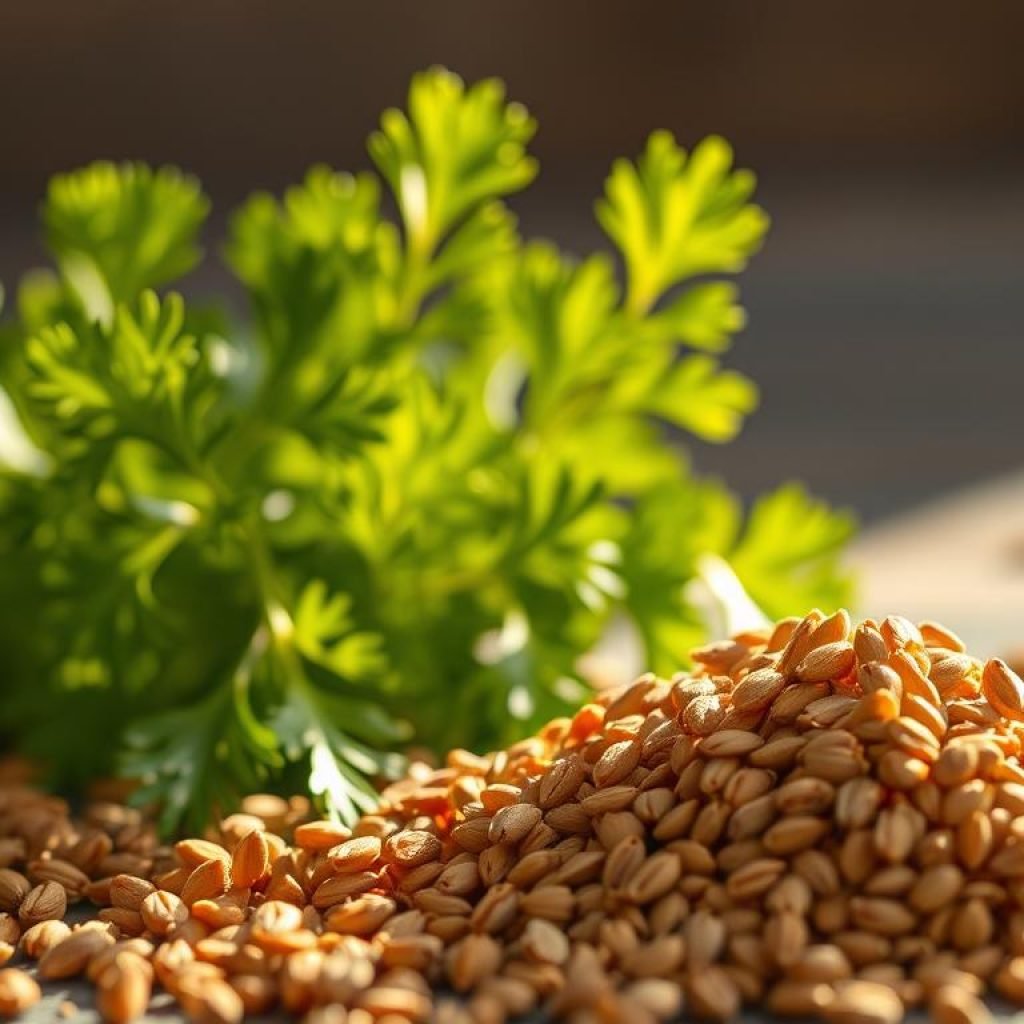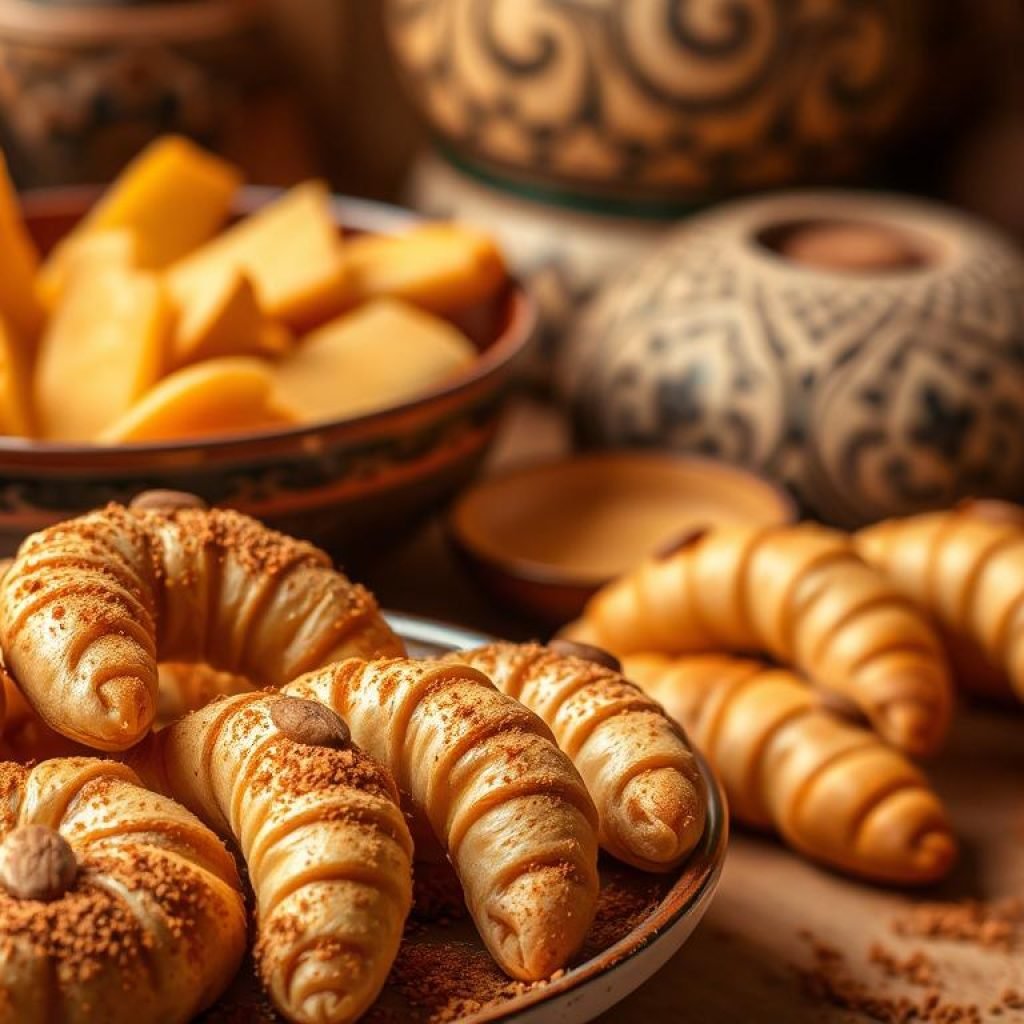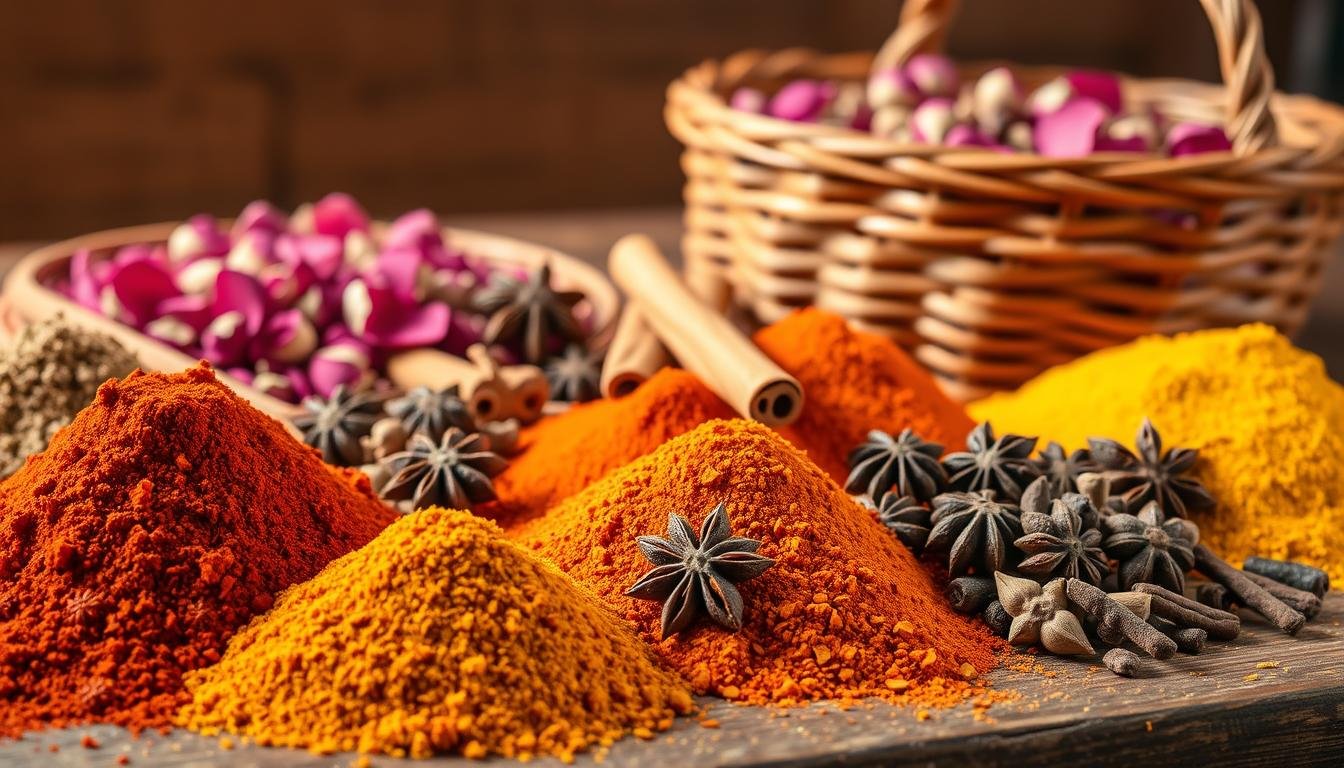What makes Moroccan cuisine so special and flavorful? Which Moroccan spices are key for making these dishes at home? Moroccan spices bring the rich, aromatic flavors of Middle Eastern cuisine to life. They are essential for authentic Middle Eastern cooking, making your dishes stand out.
Exploring Middle Eastern cuisine means learning about the top Moroccan spices. These spices, from cinnamon’s sweetness to cumin’s earthiness, are vital. They add depth and warmth to your cooking, bringing Moroccan flavors right to your kitchen.
Introduction to Moroccan Spices
Discovering Moroccan spices is a journey into Middle Eastern culture. With the right spices, you can make everything from hearty stews to flavorful tagines. The secret to Moroccan cooking is blending spices to create unique flavors.
Key Takeaways
- Moroccan spices are a crucial component of authentic Middle Eastern cuisine
- Understanding the role of Moroccan spices can elevate one’s cooking experience
- Cumin, coriander, and cinnamon are essential Moroccan spices to have at home
- Authentic spices can add depth and warmth to various dishes
- Mastering the art of blending Moroccan spices is key to creating unique flavor profiles
- Moroccan cuisine offers a wide range of dishes to explore, from hearty stews to flavorful tagines
Understanding the Essence of Moroccan Cuisine
Moroccan cuisine is famous for its deep and complex flavors. These come from using many spice blends and cooking with spices. The mix of spices, herbs, and other ingredients gives Moroccan dishes their unique and aromatic taste.
In Moroccan cooking, spice blends are key to adding depth and warmth. These blends often include spices like cumin, coriander, and cinnamon. It’s these spices and blends that make Moroccan food stand out.
Some common spice blends in Moroccan cuisine include:
- Ras el hanout, a mix of spices with up to 30 different ingredients
- Chermoula, a blend of herbs and spices for marinating meat and fish
- Harissa, a spicy mix of chili peppers and garlic
These spice blends are essential in Moroccan cooking. They help make a wide range of dishes, from tagines and stews to salads and couscous. Knowing about spice blends and cooking with spices helps us appreciate the rich and complex flavors of Moroccan cuisine.
Exploring the Top Moroccan Spices
Moroccan cuisine is famous for its rich flavor profiles. This is thanks to a mix of Moroccan spices. These spices are key to Moroccan cooking. Knowing how to use them is crucial for making real Moroccan dishes.
In Moroccan cuisine, some spices are more important than others. You’ll find cumin, coriander, paprika, cinnamon, and ras el hanout often. Each spice brings its own flavor profile to dishes, adding depth and complexity.
What Are the Must-Have Spices?
Here are the top Moroccan spices you’ll see a lot:
- Cumin: adds a warm, earthy flavor
- Coriander: adds a sweet, citrusy flavor
- Paprika: adds a smoky, slightly sweet flavor
- Cinnamon: adds a warm, sweet flavor
- Ras el hanout: a blend of spices that adds a complex, aromatic flavor
Key Flavor Profiles of Moroccan Spices
Moroccan spices are known for their complex flavor profiles. They often mix multiple spices in one dish. By understanding these flavor profiles, you can make a variety of tasty, authentic dishes.

1. Cumin: The Groundwork of Flavor
Cumin is a key spice in Moroccan cooking, known for its earthy taste. It’s used in many dishes like stews, soups, and salads. For more on Moroccan spices and their uses, check out a trusted source.
Culinary Uses of Cumin
Cumin is great for adding flavor to many foods. It’s used in savory meats and tasty vegetables. Here are some ways to use Cumin:
- Adding depth to stews and soups
- Enhancing the flavor of grilled meats
- Seasoning vegetables and salads
Health Benefits of Cumin
Cumin is not just for cooking. It also has health perks like aiding digestion and boosting the immune system. Its health benefits make it a favorite in many traditional remedies.
2. Coriander: A Sweet and Citrus Touch
Coriander is a key spice in Moroccan cooking, known for its sweet and citrus taste. It’s a must-have in many traditional dishes, bringing depth and warmth. Knowing the difference between coriander seeds and fresh coriander is important, as each has its own flavor and aroma.
The debate over seeds vs. fresh coriander is common among chefs and home cooks. Coriander seeds have a strong, earthy taste. Fresh coriander, or cilantro, has a brighter, more citrusy flavor. Use seeds in stews and braises to let their flavors simmer. Fresh coriander is great for adding freshness to salads, salsas, and cold dishes.
How to Use Coriander in Dishes
- Use coriander seeds in slow-cooked meals, such as stews and braises, to add depth and warmth.
- Add fresh coriander to salads, salsas, and other cold dishes for a burst of freshness and citrus flavor.
- Combine coriander with other spices, such as cumin and cinnamon, to create a unique and aromatic blend.

Differences Between Seeds and Fresh
In summary, coriander seeds and fresh coriander have different flavors and uses. By understanding these differences, you can fully enjoy this versatile spice. It adds a sweet and citrus touch to your Moroccan-inspired dishes.
3. Paprika: Adding Depth and Color
Paprika is a versatile spice that adds depth and color to various dishes. It’s a staple in Moroccan cuisine, loved by chefs and home cooks. The debate between sweet and hot Paprika is ongoing, each with its own uses.
In Moroccan cooking, Paprika adds a smoky, slightly sweet flavor. The sweet variety is used for mild flavors, while the hot adds a spicy kick.
Types of Paprika
There are several types of Paprika, including sweet, hot, and smoked. Each type has a unique flavor and is used in different dishes. Some of the best dishes to use Paprika include:
- Chicken and vegetable tagines
- Spicy stews and soups
- Couscous with vegetables and meat
Best Dishes to Use Paprika
Choosing the right type of Paprika is key in cooking. Sweet Paprika is great for mild flavors, while hot Paprika is best for spicy dishes. Popular dishes that use Paprika include chicken and vegetable tagines, spicy stews and soups, and couscous with vegetables and meat.
4. Cinnamon: Sweet and Savory Harmony
Cinnamon is a versatile spice that brings a sweet and savory taste to many dishes. It’s a key part of Moroccan cuisine. Its warm, aromatic flavor shines in Moroccan sweets, where it’s mixed with other spices for a unique flavor.

Cinnamon in Traditional Moroccan Sweets
Cinnamon is a main ingredient in traditional Moroccan sweets like ghriba and makroud. These sweets combine Cinnamon, sugar, and spices. This mix creates a sweet and savory taste that’s typical of Moroccan cuisine.
Unique Savory Dishes Featuring Cinnamon
Cinnamon isn’t just for sweets; it’s also in savory dishes like stews and tagines. In these, Cinnamon adds a warm, aromatic flavor. This flavor works well with spices like cumin and coriander, making the taste rich and complex. Chicken and lamb tagines, as well as vegetable stews, often include Cinnamon.
5. Ras el Hanout: The Spice of the Chef
Ras el Hanout is a key spice in Moroccan cooking. It’s a mix of spices like cumin, coriander, cinnamon, and paprika. The name means “head of the shop,” showing it’s the best spice a vendor offers.
There are many ways to use Ras el Hanout. It adds depth to dishes like tagines, stews, couscous, and vegetables. It’s also great in Moroccan sauces and marinades. For the best flavor, mix it with other spices and herbs.
- Adding it to tagines and stews for a boost of flavor
- Using it as a rub for meats and vegetables before grilling or roasting
- Mixing it with olive oil and lemon juice to create a marinade for chicken or fish
Using Ras el Hanout in your cooking brings Moroccan flair to any dish. It adds warm, aromatic flavors. Whether you’re a pro chef or new to Moroccan cooking, Ras el Hanout is essential.
Where to Buy Authentic Moroccan Spices
Looking for authentic Moroccan spices? Knowing where to shop is key. You can find them online or in stores. For online shopping, start with reputable spice sellers websites.
Online shopping is easy, but local stores offer a unique experience. They have a wide range of authentic Moroccan spices. Plus, the staff can give you tips on using them.
Best Online Retailers for Moroccan Spices
Online, look for sites that focus on international ingredients. They have a big selection of authentic Moroccan spices. You can find rare spices too.
Local Stores to Explore for Fresh Spices
Prefer shopping in person? Local stores are perfect. Many cities have markets or stores with authentic Moroccan spices. They offer the freshest and best quality spices.
Storing Moroccan Spices for Freshness
To keep Moroccan spices fresh, it’s key to store them right. Storing spices in a cool, dry spot is vital. This helps keep their smell and taste. Use optimal containers that seal tight and keep moisture out.
Here are some tips for preserving aroma and flavor:
- Store spices in a cool, dry place, away from direct sunlight and heat sources.
- Use airtight containers to prevent moisture and air from entering.
- Keep spices away from strong-smelling foods, as they can absorb odors easily.
Choosing the right optimal containers is crucial. Glass jars with tight lids or spice tins with airtight seals are great options.
By following these tips and using the right containers, you can enjoy Moroccan spices longer.
| Container Type | Benefits |
|---|---|
| Glass Jars | Airtight, moisture-proof, and non-reactive |
| Spice Tins | Compact, airtight, and easy to store |
Creative Ways to Incorporate Moroccan Spices
Moroccan spices can make any dish special, from traditional tagines to new recipes. By trying creative ways to use these spices, you can make your cooking stand out. You can mix Moroccan flavors with other ingredients to create tasty and unique dishes.
Think about adding ras el hanout to roasted veggies, or using cumin and coriander in burgers. You can also add cinnamon and ginger to oatmeal or yogurt. These spices are great for making tasty marinades for meats, seafood, or tofu.
- Chicken tagine with preserved lemons and olives
- Spiced lamb burgers with harissa mayo
- Roasted sweet potato and carrot salad with cumin and paprika
These ideas show how versatile Moroccan spices are. They can inspire you to try new things in your cooking. By exploring Moroccan flavors, you can make your meals more exciting for yourself and your family.
Conclusion: Elevate Your Cooking with Moroccan Spices
The world of Moroccan spices is full of exciting flavors. You’ve learned about cumin’s earthy warmth and coriander’s citrusy taste. These spices can make your cooking better and take your taste buds on a fun journey.
Now you know how to use Moroccan spices in your cooking. You can try new flavors and make dishes that show off Moroccan cuisine’s richness. Just remember to start small, taste as you go, and follow your senses.
Adding Moroccan spices to your cooking can be a game-changer, whether you’re experienced or just starting. It can lead to many new and exciting dishes. So, dive into the world of Moroccan spices, try new recipes, and let your kitchen become a place of discovery.




Comment (0)